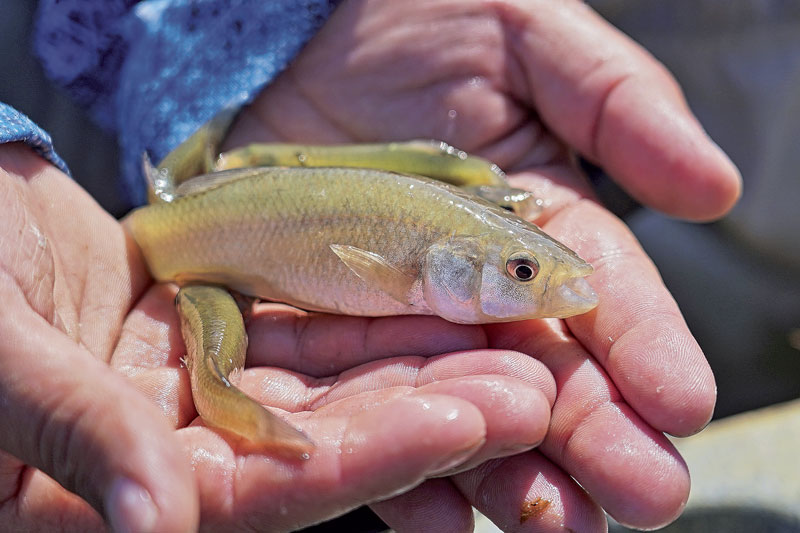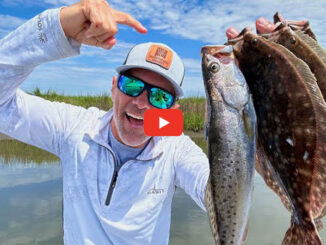
Just about anything that swims will gobble up a cocahoe minnow
The only thing constant in April is change. The trout are still in the marshes, but starting to move to saltier waters for the beginning of the upcoming spawning season. They are scattered, but if you find them, they are hungry. One way to up your odds is to fish with the other live bait — cocahoe minnows.
A wide variety of hard and soft lures all work well this time of year. However, spring signals the kick-off of the topwater bite and there really is no more exciting way to catch fish, especially in a kayak. Being basically at water level for topwater explosions is a thrill you will not soon forget.
However, if you are looking for limits, live bait is never a bad option. Live shrimp, a popular spring and summer favorite bait works great, but availability is hit or miss until the season gets more consistent come May. Shrimp are also more difficult to keep alive in a kayak without a dedicated live well. Also, early season shrimp are typically quite small.
But there is another and it’s a good one!
The venerable live cocahoe minnow is a great live bait for kayak fishing for all inshore species. Reds, trout, drum and flounder can’t resist a chunky, feisty, cocahoe. A bonus for those that fish the many coastal areas with a mix of freshwater species, bass and catfish also readily attack live cocahoes.
Easy to keep
Cocahoes are hardy and require no sophisticated livewell to keep them healthy throughout a long day on the water. A small bucket with a simple battery-powered aerator can keep them alive for a few days. Floating minnow buckets also work well. The buckets can be towed along when slowly fishing, but should be placed in the kayak when traveling as they create a lot of drag that makes paddling/pedaling more difficult. I once kept several cocahoes alive for a couple hours swimming in a cup holder on the ‘yak. A friend was heading in and gave me a few he had left from the morning’s fishing. One of them was placed under a popping cork and turned into a tournament winning redfish.
Cocahoes can be found year-round at many marinas and bait shops. They are tolerant of a wide range of water temperature and salinities. Also, if you want to catch your own, a funnel-style minnow trap baited with fresh cracked blue crab does the trick.
Cocahoes work well rigged in a variety of styles. Freelined on a light hook, under a popping cork, or on a Caroling rig bouncing the bottom all produce fish. On a recent trip, out of Hopedale, James Kellum brought along a bucket of cocahoes. Kellum opted to slowly work the minnow on a Carolina rig at various water depths. After several undersized specks, he landed a nice 14-inch keeper trout. Shortly thereafter, he set the hook on a big bull redfish that put up a 15-minute fight on light casting gear.
The morning continued with several more specks, another bull red and a couple of small flounder. Then, there was a mystery beast (likely another big bull or black drum) that found its way into a crab trap line and broke off with no positive identification.
As the wind picked up, the kayaks headed for the protection of a couple of interior marsh canals and the cocahoes continued to attract a couple of keeper slot reds and a few throwback rat reds. One nice fat bass also couldn’t resist the wiggly cocahoe.

Feast or famine
While travel distances in a kayak are somewhat limited, moving from spot to spot is fairly simple. Sometimes, moving from one end of a pond to the other can be the difference between feast or famine.
Fishing interior marshes offers access to a variety of water depths. In early spring, fish are found at various depths, moving shallower as water temps start a steady spring rise. However, the temps can change by a few degrees either way with a few weak straggler cold fronts.
Of course, “deep water” in the marsh is a relative term. Five to six feet in many places is considered deep. This makes it easy to park your kayak with the use of a stake-out pole. The poles are quick and easy to set with virtually no noise. A wide variety of poles are sold by kayak accessory manufacturers and there are also several inexpensive DIY varieties that can be found on YouTube. Power-Pole electric options have also become popular with many kayakers as the simple press of a button deploys and retracts the pole. Use of a pole rather than an anchor makes it quick, quiet, and easy to move and set up on a variety of spots.
If conditions allow, try the cocahoes in all depths of the water column. Laying one next to the bank under a cork is a great way to find reds and flounder. That same set up worked off a point or opening to a small drain may be the ticket to a limit of specks.
My absolute favorite is on a Carolina rig with a light hook. The weight keeps the minnow near the bottom, but able to stay up a few inches and struggle. This distress and vibration is a feeding trigger that fish cannot resist.
Next time you head out for an early spring kayak trip, stop by your local bait dealer and pick up a few dozen live cocahoes. You’ll be glad you did.


